How SK Telecom T1 has shaped the narrative of Korean teams at international League of Legends events
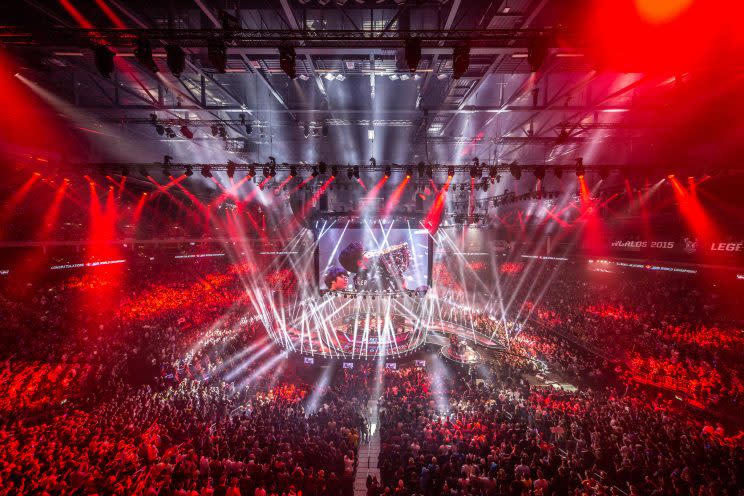
When the SK Telecom T1 #2 lineup won the Season 3 League of Legends World Championship, they were simply SK Telecom T1.
Just over seven months since they were formed as SK Telecom T1’s second League of Legends team, Lee “Faker” Sang-hyeok’s SKT added two major trophies to their case — the OnGameNet’s Champions trophy and the Summoner’s Cup. Even then, the argument of which trophy was a greater achievement lingered as the confetti showered over SKT on the Staples Center stage.
The fact that Jian “Uzi” Zhihao’s Royal Club appeared to never have stood a chance against the SKT juggernaut in the Worlds finals only helped support growing clamor that winning a LoL World Championship was easier than winning a domestic title in Korea. SKT’s best-of-five series against the KT Rolster Bullets in the OGN Champions 2013 Summer Finals was already being hailed as the best series in the game’s competitive history before SKT stepped into the international spotlight in Los Angeles.
A quick three games was all it took for SKT to dispatch of Royal Club. Their reverse sweep of KTB, nearly a month prior, had gone a grueling five games, with SKT visibly adjusting within the series itself in order to overcome KTB’s fast turret pushes. SKT hardly had to adjust against Royal Club, sticking to similar team compositions in a 3-0 drubbing. Fellow OGN Champions veteran NaJin Black Sword put up a greater fight against SKT in the Worlds semifinals.
The original SK Telecom T1 #1, formerly Bok “Reapered” Han-gyu’s squad, was under construction at the time, leaving what had been SK Telecom T1 #2 as the default SKT lineup. In the following Champions season, the two teams were renamed S and K, presumably to remove the idea of a hierarchy between them — the #2 team was already far more successful.
On Oct. 4, 2013 this team was immortalized as SK Telecom T1, the one known team under the SKT banner despite the existence of their sister team. The first Korean World Champion. No other region has taken the Summoner’s Cup since, and two of these three successive Korean victories have been claimed by SKT themselves. It was here that SKT first defined the narrative of Korean teams at international events — the powerhouse region that cannot be defeated.
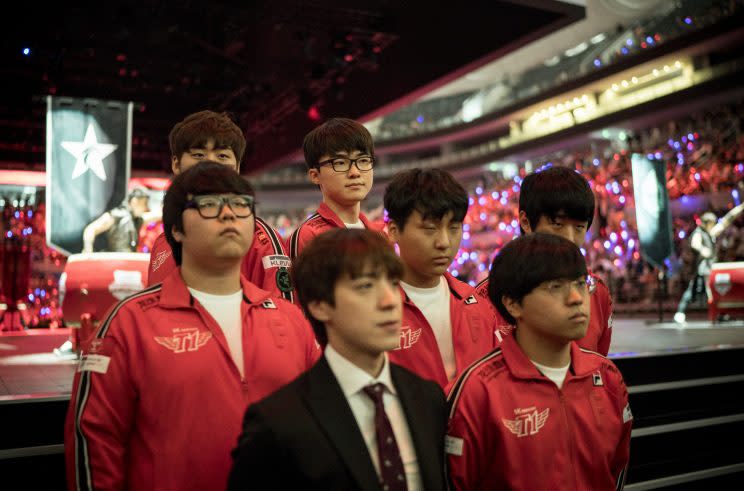
The Champions Tournament and the Season 2 World Championship
Korea established itself as a major player in League of Legends OGN’s two tournaments in 2012 — Champions Spring and Champions Summer, following the success of the OGN LoL Invitational in January 2012. Although infrastructure has become an overused word in attempts to simplify Korean dominance at international events, pre-existing experience with StarCraft: Brood War helped expedite the process of competitive LoL in Korea.
By extension, OGN propelled Korean LoL forward with these tournaments, giving teams a structured arena where they could hone their skills. However, these tournaments were not exclusive.
Champions Spring 2012 saw North America’s Counter Logic Gaming and Europe’s Fnatic in attendance. In Champions Summer 2012, nearly a third of the teams were not Korean. This included both CLG teams, Dignitas, World Elite, and Natus Vincere.
The most important thing to remember about the so-called wilderness of Season 2 is that there were no regional leagues. Teams were generally free to compete in whatever tournaments cropped up, provided that they were extended an invitation, qualified, or could make the trip to participate. It’s natural that teams outside of Korea would have gravitated towards the strongest tournament at that time, provided schedules allowed.
Schedules themselves were far more open. Most larger tournaments were international by default, including the Major League Gaming Circuit and Intel Extreme Masters. The only professional League of Legends league belonged to Garena and was an international league by design. The Garena Premier League included teams from Taiwan, Vietnam, Singapore, Malaysia, the Philippines, and Thailand in an effort to give Southeast Asian teams a chance to compete against each other despite the distance.
Where Season 1 had primarily European and North American teams participating with one Singaporean team and one Filipino team, the Season 2 World Championship was touted as the international event of the year. The tournament opened with a video mash-up of various players in attendance saying, “I play League of Legends in” before stating their country or city — Belgium, Miami, Moscow, China, Vancouver, Vietnam, Spain, New York, Korea, Scotland, Calgary. This was then reversed, and certain players listed the various cities where they had played LoL in the past year. The absence of boundaries permeates the narrative of Season 2.
Going into the Season 2 World Championship, Korea was generally accepted as the strongest region in the world, but this didn’t guarantee them the Summoner’s Cup in prevailing fan and caster commentary. Europe’s Moscow 5 was cited by many as a Worlds contender, along with CLG.EU, Team SoloMid, and Korea’s Azubu Frost. The eventual winner, Taiwan’s Taipei Assassins, flew under the radar coming into the event and left with no small amount of international fans. In the later stages of the tournament, and following Season 2 Worlds, it was revealed that TPA were some of the most formidable scrim partners at the event, earning respect from their international competitors.
Although it was technically out of season, Season 2 ended with one of the greatest international tournaments in League of Legends history — IGN’s IPL 5. It featured a sixteen-team round robin group stage for seeding, and an expansive double-elimination tournament bracket. In the bracket stage alone, 21 best-of-threes were played with a best-of-five final.
China’s World Elite emerged the winner, and stories again focused on the teams themselves: the players and playstyles. Caster commentary took a look at meta shifts, player comfort champions, and common compositions by team.
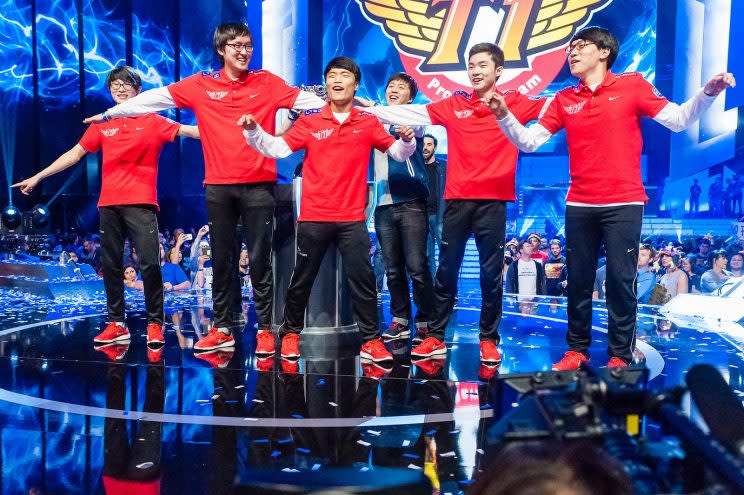
Drawing the Lines — Season 3
Seeds of division were sown in Season 3, a side effect of fracturing the LoL competitive scene by region.
On February 7, 2013, domestic rivals Team SoloMid and Counter Logic Gaming faced each other in the first match of the Riot League Championship Series Season 3 Spring (LCS) in North America. Two days later, rivals SK Gaming and Fnatic opened the Spring LCS season in Europe. Over in China, Livemore and Wings of Aurora kicked off Tencent’s first LoL Pro League that March. Korea already had the OGN Champions tournament, which then by default became an all-Korean tournament only, held in Winter, Spring, and Summer. Garena continued to run their GPL for Southeast Asian teams.
The rise of these leagues sorted teams by geographical region, which meant less time to gather top teams from different locations for international events. In early March, IGN announced the cancellation of IPL 6, the anticipated successor to IPL 5.
“When we launched IPL two years ago, the esports landscape was very different with far fewer events than we have now,” IGN said. “Today, game publishers are holding their own tournaments, which is why we are not ready to commit the resources at this time to run another major independent event.”
Although their statement doesn’t directly mention Riot Games, it’s easy to see how they played a part in the tournament’s demise. Teams from major regions were already competing in the LCS, LPL, or Champions, and prepping for weekly matches within their own regions.
IEM remained an independent international circuit, but others faded away. GIGABYTE’s StarsWar, which included both Chinese and Korean teams, ended July 2013 with StarsWar 8. Major League Gaming held their last LoL event in May 2013, and it only included North American teams — the scheduled LCS matches for that week in addition to their own Spring Championship with four NA teams from an online qualifier.
Effectively isolating regions from each other, the regional leagues also all fed directly into the Season 3 World Championship, which became the default international event of 2013. From the beginning, the Season 3 World Championship had a different flavor than Season 2. While regional differences and styles had always been a backdrop, the focus of Season 2 Worlds was on coming together. Instead, Season 3 pitted regions against each other, not teams.
The 2013 analyst desk often joked along regional lines, with a variety of experts from different leagues weighing in on their respective regions. Most famously, the desk saw the birth of Christopher “MonteCristo” Mykles’ unforgettable line, “All aboard the Korean hype train!” complete with an SK Telecom T1 conductor’s hat, a whistle, and tickets to distribute to his fellow desk mates. When SK Telecom T1 hoisted the Summoner’s Cup, they became the face of Korean dominance in League of Legends.
The connection between SKT and Korea’s performance at international competitions had been established, and it came at a time when the community learned to evaluate tournaments as regional clashes rather than team against team.
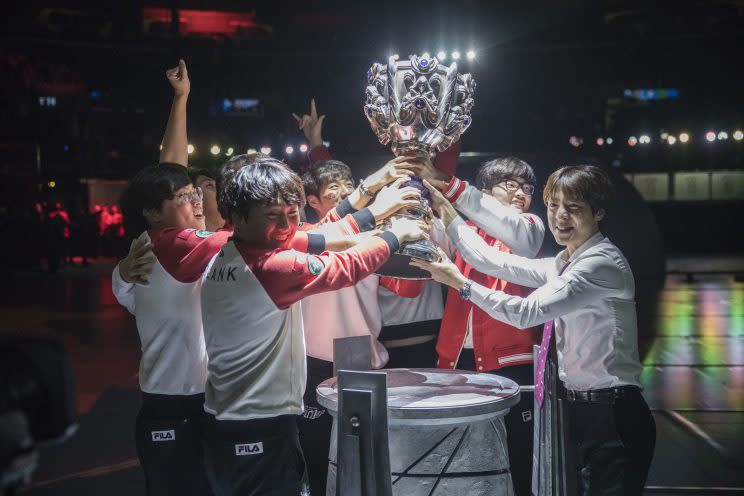
What does SKT have to do with it?
The Season 3 Worlds results only backed up Monte’s claim. Royal Club were outclassed by SKT in their Finals series. Only Oh My God in the group stages and NaJin Black Sword in the semifinals were able to stand up to SKT at all during the tournament. Naturally, the war of regions begat the ranking of regions, with Korea at the top and the rest to squabble for positioning below.
Since then, SKT have won two more World Championships, a Mid-Season Invitational, and an IEM Championship. Of the ten available international LoL events since the Season 3 World Championship, including the most recent 2017 IEM World Championship, SKT has represented Korea at six of them. Of those six events, they’ve only lost one — the 2015 Mid-Season Invitational against Edward Gaming.
With this rate of success, it’s easy to see why they’ve made Korean dominance their own. They are a Korean team. They hail from the best region. They have the best player in the world in Faker. They rarely lose.
This attitude wasn’t solely prevalent in international discussions. Within Korea, SKT also monopolized headlines. Upon returning to Korea after the Season 3 World Championship win, they went undefeated through 2013-14 Champions Winter. When they began to falter that Spring, more attention was paid to SKT T1 K’s woes rather than the rise of the two Samsung sister teams. Individual SKT T1 K members were cited as the team’s downfall, especially when support Lee “PoohManDu” Jeong-hyeon — veteran in-game leader and rumored Chae “Piglet” Gwang-jin handler — stepped down for health reasons.
SKT T1 K lacked identity. They did not adjust well to the 2014 Spring meta of turret pushing. Jungler Bae “bengi” Seong-woong was preoccupied with babysitting top laner Jung “Impact” Eon-yeong in the early game, making for more predictable jungle routes. Throughout all of 2013 and Winter 2014, bengi had evolved into a reliable force responsible for much of SKT T1 K’s vision line, snowballing Faker while shutting down his jungle opponents. The meta necessitated double jungle routes, eliminating his strengths.
In the 2014 Champions Spring group stages, the 1-1 tie with sister team SK Telecom T1 S, and later SKT T1 S’ loss to Prime Optimus, led to no small amount of speculation that the two sister teams were colluding to get SKT T1 K out of groups. Years later, it’s now painfully obvious that SKT T1 K adjusted to the meta remarkably poorly, but at the time, they continued to monopolize the discourse. More than the rise of the KT Rolster Arrows, the steady improvement of sister team SKT T1 S, or the ascendency of both Samsung teams, the demise of SK Telecom T1 K after a peerless 2013-14 Winter was the discussion du jour.
Samsung Galaxy Ozone/White sent SKT T1 K packing twice in the Champions Spring and Summer Quarterfinals — the origin of the now-popular joke that only a Samsung team can defeat SKT, yet another nod to SKT’s reign over the region and the world.
This narrative of dominion was never extended to their sister team, SK Telecom T1 S. Despite the fact that SKT T1 S were the stronger team during 2014 Champions Summer — and nearly knocked off the KT Rolster Arrows before they could get to the Finals — SKT T1 K still reigned supreme in fans’ hearts and publicity. Once the KT Rolster Arrows fell to NaJin White Shield in the Regional Qualifier, most preemptively congratulated SKT T1 K on Korea’s third seed. Until White Shield played spoiler, it seemed inevitable that SKT T1 K would represent Korea on the Worlds stage once more.
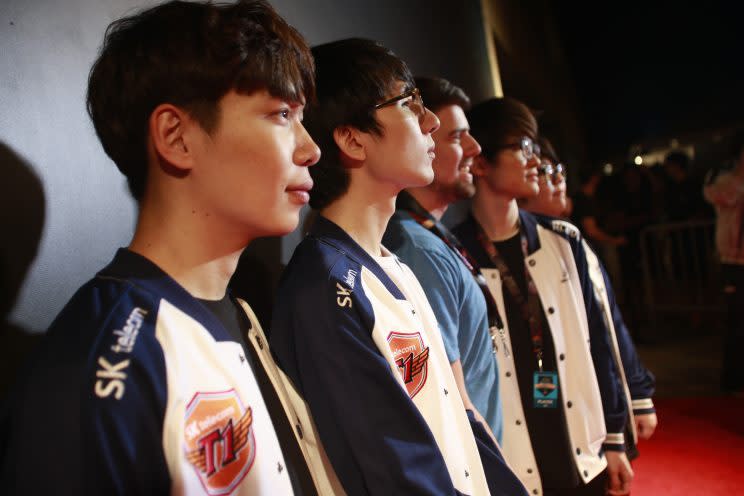
SK Telecom T1 is Korea’s representative – Seasons 5 and 6
Since 2013, separation — geographical separation, not figurative competitive gaps — between regions has only grown. The World Championship reigns as the international event for any League of Legends competitive season, despite the existence of the more recently-introduced Mid-Season Invitational. This has led to analysis by region, often at the cost of examining how teams themselves take to the Rift.
In a world where international competitions are few and far between, the glut of games in domestic leagues make it near-impossible to keep up with every region, especially with nearly all major regions switching to best-of-threes for their regular season matches. Fans, viewers, and even regional analysts rely on other regional analysts and casters to inform them about teams from that region.
It’s up to them to ensure that analysis doesn’t default to, “Korea is the better region so Korea will win” not because Korea isn’t the best region and not because a Korean team won’t win, but because this is lazy and doesn’t tell viewers or readers about the teams themselves.
SK Telecom T1 represented Korea at the 2015 and 2016 League of Legends World Championships. They also were the Korean representative at both Mid-Season Invitationals in those years, and won all of these events save one. Their playstyle, in the minds of many, has become the default Korean playstyle. When coaches, analysts, and casters speak of the Korean playstyle, they are all-too-often referencing SK Telecom T1’s unparalleled ability to punish teams’ mistakes in the mid-game.
Since 2015, the year of the sister team merger, SKT has played this controlled style that swiftly punishes opponents for mid-game weaknesses. When all else fails — and this happens infrequently — they can rely on Faker, who is always lurking and able to single-handedly turn a losing game into an SKT victory.
Following their 2014 struggles, the addition of Bae “Bang” Jun-sik and Lee “Wolf” Jae-wan was still a perceived downgrade to Piglet and Pooh, but gave SKT a safer bottom lane. This allowed bengi to focus more on former SK Telecom T1 S, and starting SKT top laner, Jang “MaRin” Gyeong-hwan. After another relatively slow start in 2015, and the team’s insistence on swapping between Faker and former SKT T1 S mid laner Lee “Easyhoon” Ji-hoon, SKT finally adjusted. The Cinderhulk patch that came late in 2015 spring suited bengi perfectly, and even then, the team also swapped in Im “T0M” Jae-hyeon when they wanted a more aggressive style.
After their defeat at the 2015 Mid-Season Invitational to EDward Gaming, SKT continued to hone this reactive, mid-game punish style. More often than not, bengi was found near the top lane to snowball MaRin. Faker evolved into an even more efficient mid laner than he had been in 2013 or 2014. They dazzled the stage at the 2015 World Championship at a time when many were left unsure of the strength of Korea thanks to EDG’s MSI victory and the mass exodus of top-tier Korean talent at the beginning of that year. More eyes were on SKT than ever before, and they only dropped one game, Game 3 to the then-KOO Tigers in the 2015 World Championship Final.
SKT grappled again with meta shifts in 2016. With the rise of DPS carry junglers, bengi was unable to play his classic style, and only looked truly comfortable while on Elise. The team put him on Udyr, Rumble, and Graves before starting Kang “Blank” Sun-gu for IEM Katowice, the remainder of the split, and the 2016 MSI. Although Blank garnered more criticism than any SKT League of Legends player in the history of the organization, SKT emerged victorious at both events.
Without bengi, Faker was more frequently punished for positioning too far forward in lane. New top laner, Lee “Duke” Ho-seong wasn’t communicating well with the rest of the team, and it took time for them to adjust to his default, split-pushing style. Blank made mechanical errors that were quickly and universally panned by domestic and international fans alike.
The Tigers, with former NaJin e-mFire jungler Han “Peanut” Wang-ho, were the best team in Korea, yet remained unable to defeat SKT. This too, added to the SKT narrative. Their clash at the 2016 League of Legends World Championship is one of the best series that Worlds has delivered. At the end of the evening, SKT emerged victorious once more, 3-2 over the favored Tigers.
Throughout, SKT continued to evolve their more reactive and punishing style. Using Faker as a pivot point, SKT has been malleable enough to continue their dominance while sticking to this tried and true form. As such, the narrative around Korea itself has evolved into an inaccurate perception that all Korean teams play like SK Telecom T1.
They do not.
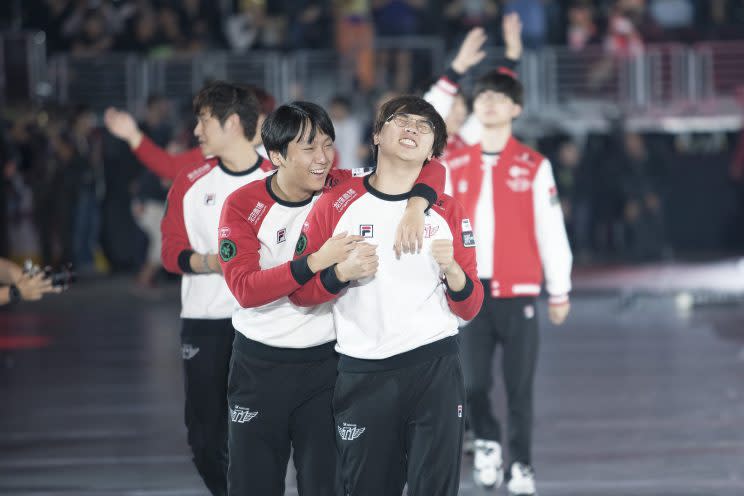
Shattering the illusion of the Korean playstyle
SKT’s reputation as the Korean League of Legends Platonic ideal does a disservice to other teams in Korea, simultaneously making it seem as if SKT are faultless.
They are not.
Every League of Legends team, even SKT, has weaknesses. What SKT also have is unparalleled execution and the best player in the world. All too often, teams fighting against SKT will have a strong game plan to defeat them, but fail to execute it properly.
KT Rolster were ripped apart for their perceived early-game focused drafts against SKT earlier this split. In both of their regular season series, SKT bested KT 2-1, a worse record than their recent finals clash which was a decisive 3-0 stomp for SKT.
Yet KT’s approach wasn’t misguided, it was their communication and execution that were awful.
Teams who have bested SKT have often done so with strong early and mid game lane assignments, pushing lanes, and deftly prioritizing where to grow their lead next. They often find victory in somewhat risky aggression, like Afreeca Freecs’ Lee “Spirit” Da-yoon’s Level 2 invade in Game 1 of the Freecs’ first regular season series against SKT this past spring.
Other teams have seen success against SKT by snowballing advantages off of Faker’s aggressive lane positioning, like the Afreeca Freecs roster of 2016 and Royal Never Give Up at the 2016 Mid-Season Invitational. From there, it’s then on that team to close the game out, something that nearly every team, including SKT, has struggled with at one point or another in their history.
SKT win with the strongest mid-to-late game execution of any team. If there was a team with similarly strong early and mid game execution, able to close out their advantages quickly, that team would likely best SKT every time.
Korea is still the best League of Legends region in the world. It’s only natural that SKT, their greatest champion, has shaped the narrative of Korean dominance. Yet, equating their playstyle to a general Korean playstyle does a disservice to all of the other creative strategies and inventive compositions that other teams employ. Extending their success to other Korean teams at international events and presuming that they will not only share SKT’s near-guaranteed success but their style as well, undermines actual analysis of what those other Korean teams bring to the table and how SKT bested them to represent Korea once more.
This attitude also glosses over what makes SKT unique and successful, generalizing an exceptional, multi-year dominion over domestic and international events as mere regional strength. SKT’s playstyle is their own, not a generic Korean playstyle. It’s time to properly celebrate SKT’s successes by highlighting what makes them so special, while giving other Korean teams their due.
Emily Rand’s love of the 2013 KT Rolster Bullets will never die. You can follow her on Twitter.


